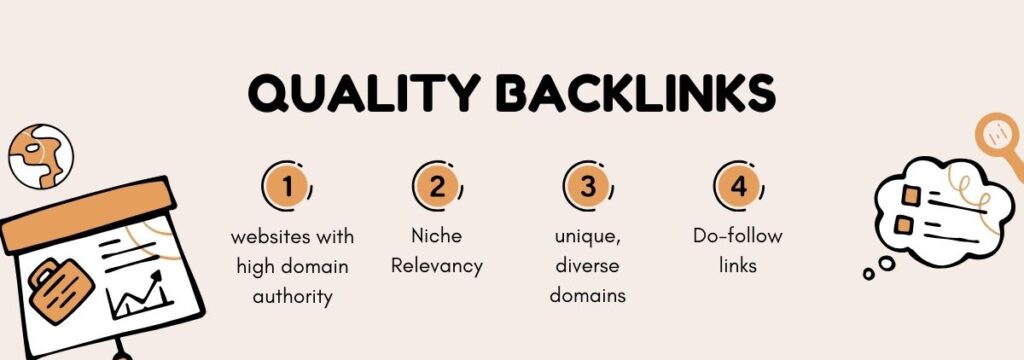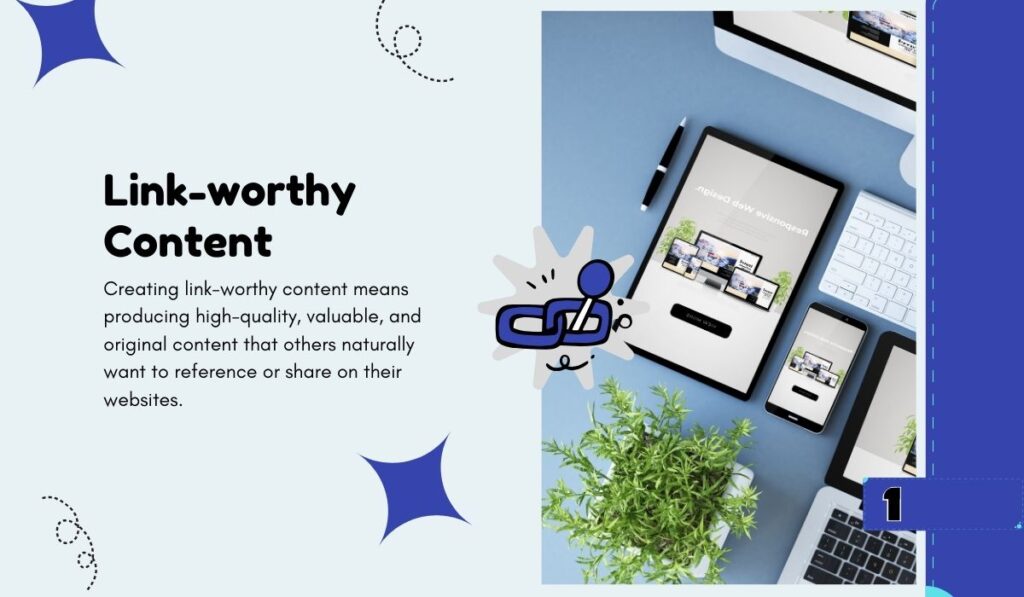Backlinks are one of the most powerful ranking factors. But not just any backlinks—quality backlinks are what search engines trust and reward. If you want your website to rank higher in Google and attract steady organic traffic, learning how to build these links the right way is a must.

In this blog, we’ll walk you through the most effective strategies to create quality backlinks in 2025, explain what makes a backlink valuable.
Table of Content:
What Are Quality Backlinks?
A quality backlink is a hyperlink from another trusted, high-authority website that points to your page. It acts as a vote of confidence, signaling to search engines that your content is valuable and trustworthy.

Key characteristics of quality backlinks:
- From websites with high domain authority (DA/DR)
- Relevant to your niche or topic
- From unique, diverse domains
- Placed contextually within content (not in the footer or sidebar)
- Do-follow links (as opposed to no-follow or sponsored)
Top Strategies to Create Quality Backlinks in 2025
1. Create Link-Worthy Content (Content Marketing)

Creating link-worthy content means producing high-quality, valuable, and original content that others naturally want to reference or share on their websites.
Think of it this way: when someone is writing a blog or creating a video and needs to refer to a helpful source, your content should be that helpful source.
Here’s how to do it well:
i) Publish Original Research or Data
If you have access to unique insights (e.g., survey results, case studies, or industry stats), package them into a blog post or infographic. Other websites, journalists, and bloggers love to cite data—and when they do, they’ll link back to you.
Example:
You surveyed 100 marketers on “How AI is changing SEO in 2025” and published the results. Now, anyone writing about AI and SEO might cite your data.
ii) Create Comprehensive Guides (Also Called Pillar Content)
These are long-form, detailed posts that explain everything about a specific topic. Google loves in-depth content, and so do readers. Other bloggers often link to these as a reference for their audience.
Example:
Instead of writing “10 SEO Tips,” create “The Ultimate Beginner’s Guide to SEO in 2025.” Add sections, visuals, FAQs, and expert tips.
iii) Use Infographics & Visual Content

Visuals simplify complex topics. Bloggers or websites often embed infographics into their own posts—and when they do, they link to the original source (you!).
Pro Tip: Always include an embed code or ask for credit when you share visuals.
iv) Offer Free Tools, Templates, or Checklists
People love free, ready-to-use resources. If you offer something helpful like a content calendar template, a free SEO audit tool, or a backlink tracker spreadsheet, others will mention and link to it in their own posts.
v) Update Outdated Content
Find popular content in your niche that’s outdated, and create a newer, better version. When other sites look for fresh links to recommend, your updated post can take its place.
Guest blogging means writing a blog post for another website (usually in your niche) to reach their audience, build your authority, and most importantly—get a backlink to your website.

But here’s the catch: not just any site will do. You want to write for high-authority websites—the ones that have strong domain authority (DA), a good reputation on Google, and an engaged audience. These backlinks have more SEO value and send trust signals to search engines.
Why Guest Blogging Works:
- Backlink Benefit: Most blogs allow you to link back to your website in your author bio or within the article. This is a natural, white-hat way to build backlinks.
- Authority Boost: Being published on a trusted site boosts your credibility and Google rankings.
- Referral Traffic: If readers like your post, they may click the link to visit your site. That’s high-quality, targeted traffic.
3. Use HARO (Help A Reporter Out)
HARO, short for Help A Reporter Out, is a free platform that connects journalists with experts like you. It’s one of the smartest (and underrated) ways to earn high-quality backlinks from authority websites—including major media outlets like Forbes, Business Insider, Times of India, and more.
How HARO Works:
- Sign Up for Free
Go to helpareporter.com and register as a source. - Receive Daily Queries
HARO sends emails 3 times a day with a list of questions from journalists across different niches (e.g., health, tech, marketing, etc.). - Pitch Your Response
When you find a relevant question, respond with a clear, expert-level answer. Include your name, title, and website link (if allowed). - If Chosen, You Get a Backlink
If the journalist picks your quote, they’ll often feature your name and link back to your site—on a trusted, high-authority platform.
Why HARO is Powerful for SEO:
- Backlinks from DA 80+ sites
Many journalists work for top-tier sites. One link from them can boost your domain authority significantly. - Builds Personal Brand & Trust
Being featured as a source shows you’re a credible expert in your niche. - Referral Traffic + SEO
These mentions not only help SEO, but can also drive relevant visitors to your site.
4. Broken Link Building
This strategy involves finding broken (dead) links on other websites and offering your content as a replacement.
Steps:
- Use tools like Ahrefs or Broken Link Checker
- Find a relevant broken link in your niche
- Create or match content on that topic
- Reach out to the site owner with a polite pitch
This method adds value to their site while earning you a solid backlink.
5. Build Relationships with Niche Bloggers & Influencers

In the world of SEO and link building, genuine relationships are gold. Connecting with bloggers and influencers in your niche is a powerful way to earn quality backlinks naturally—not just one time, but repeatedly over time.
How to Build Relationships That Lead to Backlinks:
- Start with Engagement
Begin by following bloggers/influencers in your niche on social media (especially Twitter, LinkedIn, Instagram).
Like, comment on, and share their content genuinely. - Send Personalized Emails
Once you’ve engaged for a while, reach out via email.
Don’t immediately ask for a backlink. Instead, offer value—like giving feedback on their blog post, sharing resources, or offering collaboration.
Example:
“Hey [Name], I loved your recent post on [Topic]. I’ve created something similar with a slightly different angle—would love your thoughts!”
- Offer Collaboration Opportunities
Invite them for interviews, round-up posts, or co-create content. These give both parties a reason to link to each other’s work. - Give Before You Ask
Link to their blogs in your own content first, tag them in your posts, or feature them in a round-up. When you give value first, people naturally return the favor.
6. Skyscraper Technique
The Skyscraper Technique is a proven content marketing and backlink strategy introduced by Brian Dean from Backlinko. It’s all about creating better content than what’s already ranking—then reaching out to those who linked to the original and asking them to consider linking to yours instead.
What is the Skyscraper Technique?
Imagine walking down a street full of buildings. One skyscraper stands taller, shinier, and more attractive than the rest. That’s the one people notice.
This strategy works the same way for blog posts or resources:
You find popular content with lots of backlinks, create an even better version, then promote it to the right audience (especially those who already linked to the original).
How to Do It Step-by-Step:
- Find Popular Content with Backlinks
Use tools like:- Ahrefs (Site Explorer > enter a keyword > sort by backlinks)
- BuzzSumo
- SEMrush
Look for content in your niche that has:
- High backlinks
- A lot of shares or engagement
- Outdated or incomplete information
- Create a Better Version (Your Skyscraper)
Make your content:- More updated with recent stats or trends
- More detailed (add steps, case studies, visuals, tools)
- Better formatted (use bullet points, images, clear structure)
- More visually appealing with infographics, videos, etc.
Your version should clearly offer more value than the original.
3. Reach Out to the Right People
- Export the list of websites that linked to the original post using Ahrefs or similar tools.
- Contact them with a friendly pitch like:
“Hey [Name], I noticed you linked to [Old Post] on [Website]. I’ve recently created a more up-to-date and in-depth version here: [Your URL]. You might find it more helpful for your audience!”
7. Repurpose Your Content on Other Platforms
Repurposing content means taking one piece of content and transforming it into different formats to share across various platforms. This strategy not only saves time but also helps you reach wider audiences, boost brand visibility, and most importantly — earn more backlinks.
What Does “Repurposing” Actually Mean?
Let’s say you’ve written a detailed blog post. Instead of just letting it sit on your website, you can reuse that same content in other ways:
- Turn it into a YouTube video
- Share key points as a carousel post or infographic on Instagram or Pinterest
- Break it down into short tweets or LinkedIn posts
- Create a slide deck for SlideShare
- Record an audio podcast episode
- Post a summary on Medium or Quora with a link back to your original article
FAQs
There’s no fixed number. It depends on your niche, competition, and content quality. Focus on quality over quantity.
No. Spammy, irrelevant, or low-authority backlinks can harm your SEO. Always aim for relevant and trustworthy sources.
Use tools like Ahrefs or Moz to check the domain authority, relevance, and traffic of the referring site.
Start with guest posts, directory listings, and HARO. These are accessible and offer solid returns.
Conclusion
Building quality backlinks is one of the most impactful ways to boost your SEO in 2025. By focusing on value, relevance, and ethical practices, you can grow your authority and traffic without risking penalties.
Remember: SEO is a marathon, not a sprint. Be consistent, create great content, and build relationships—and the backlinks will follow.

